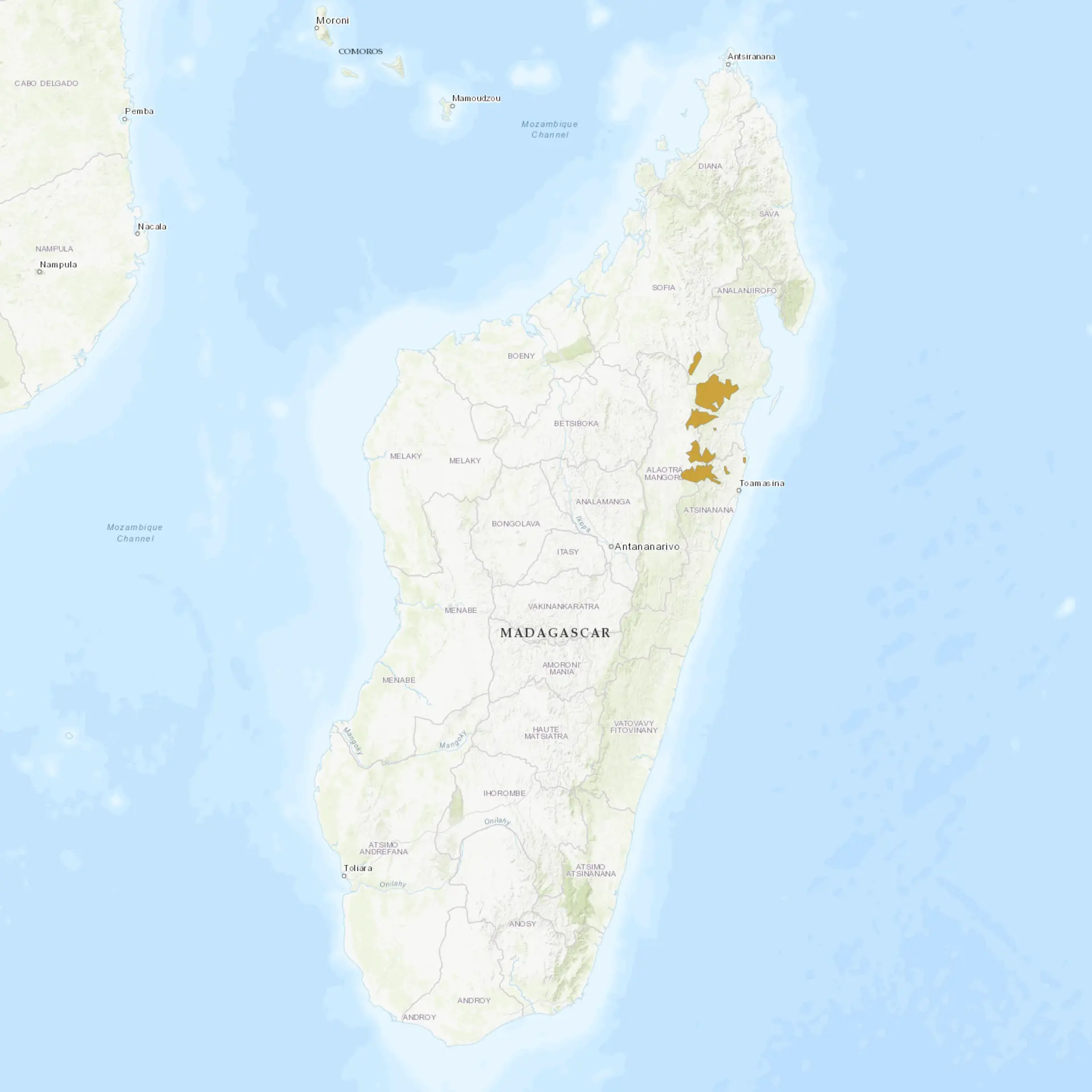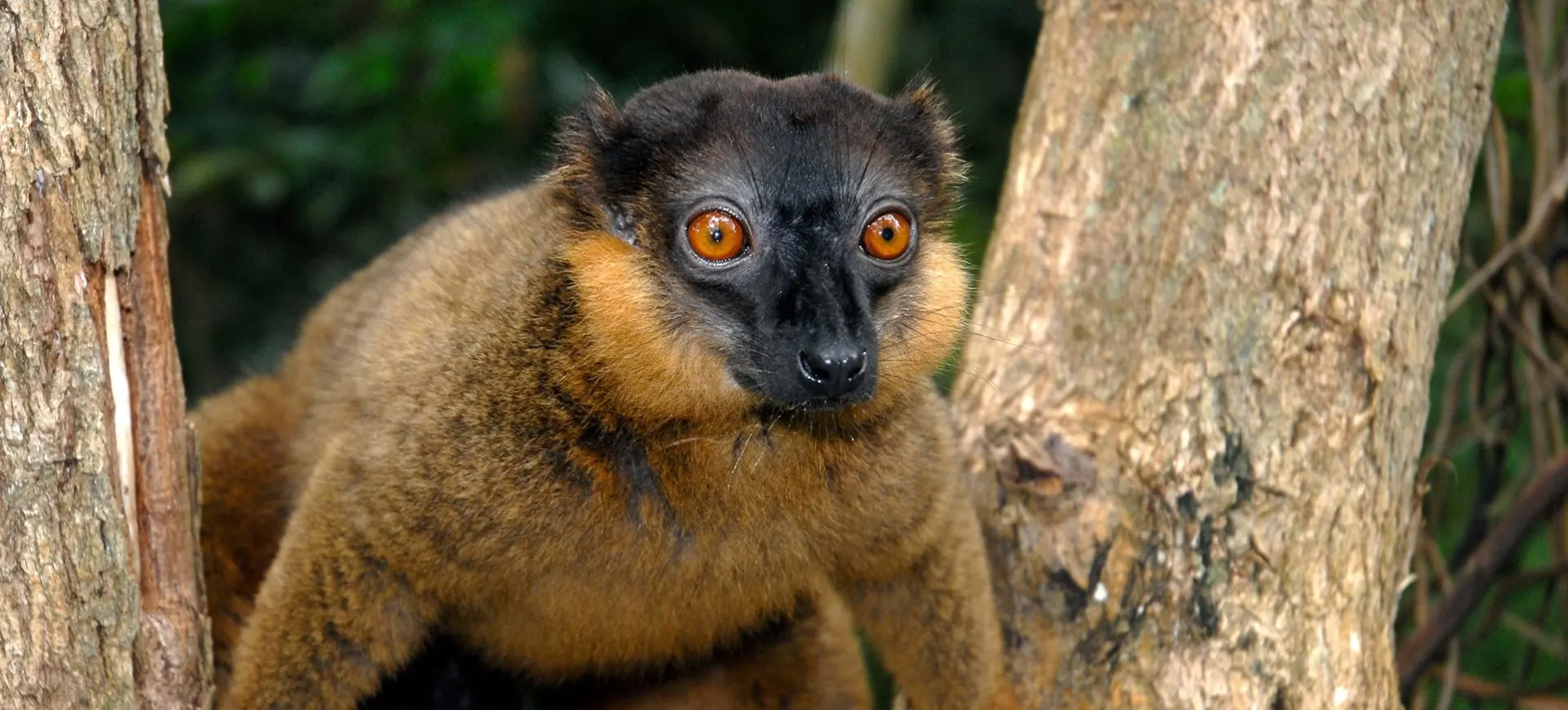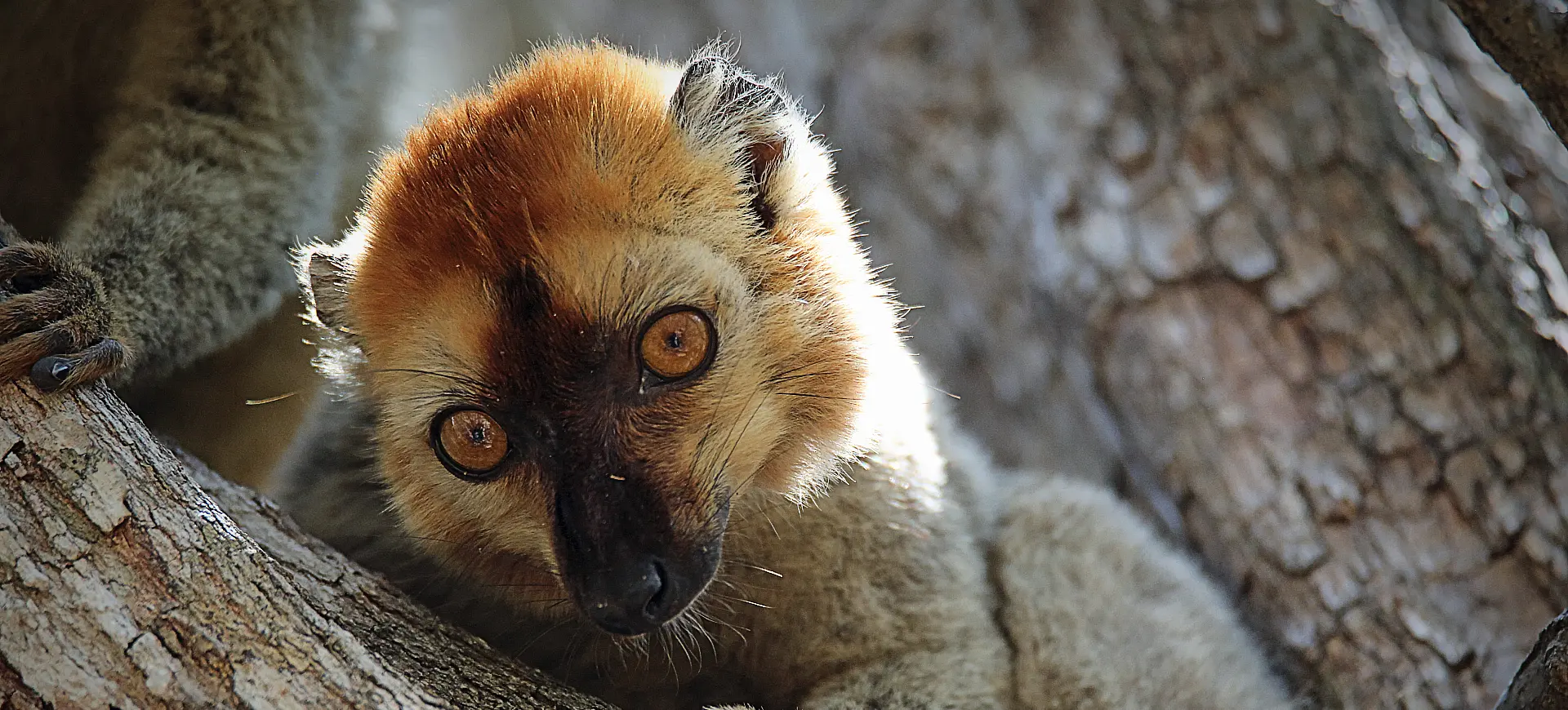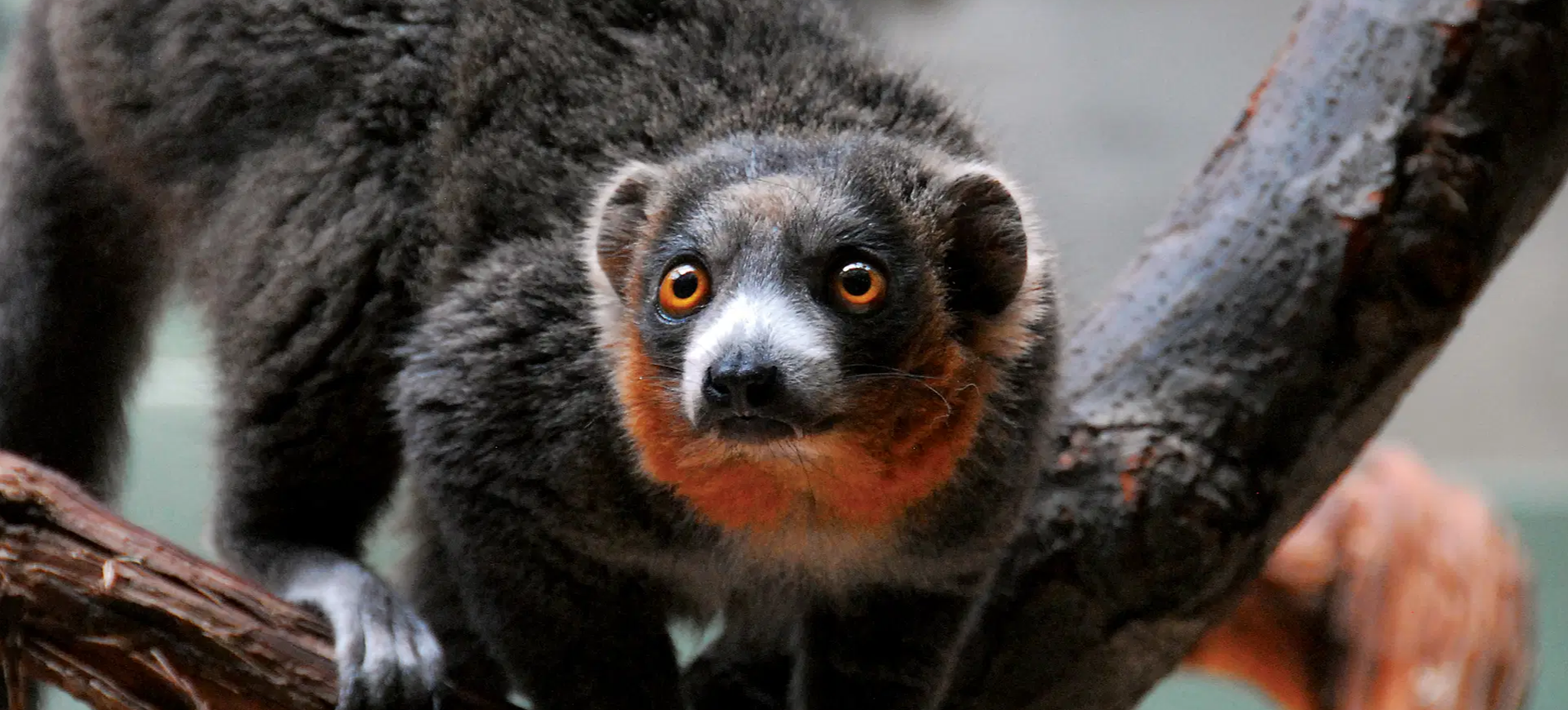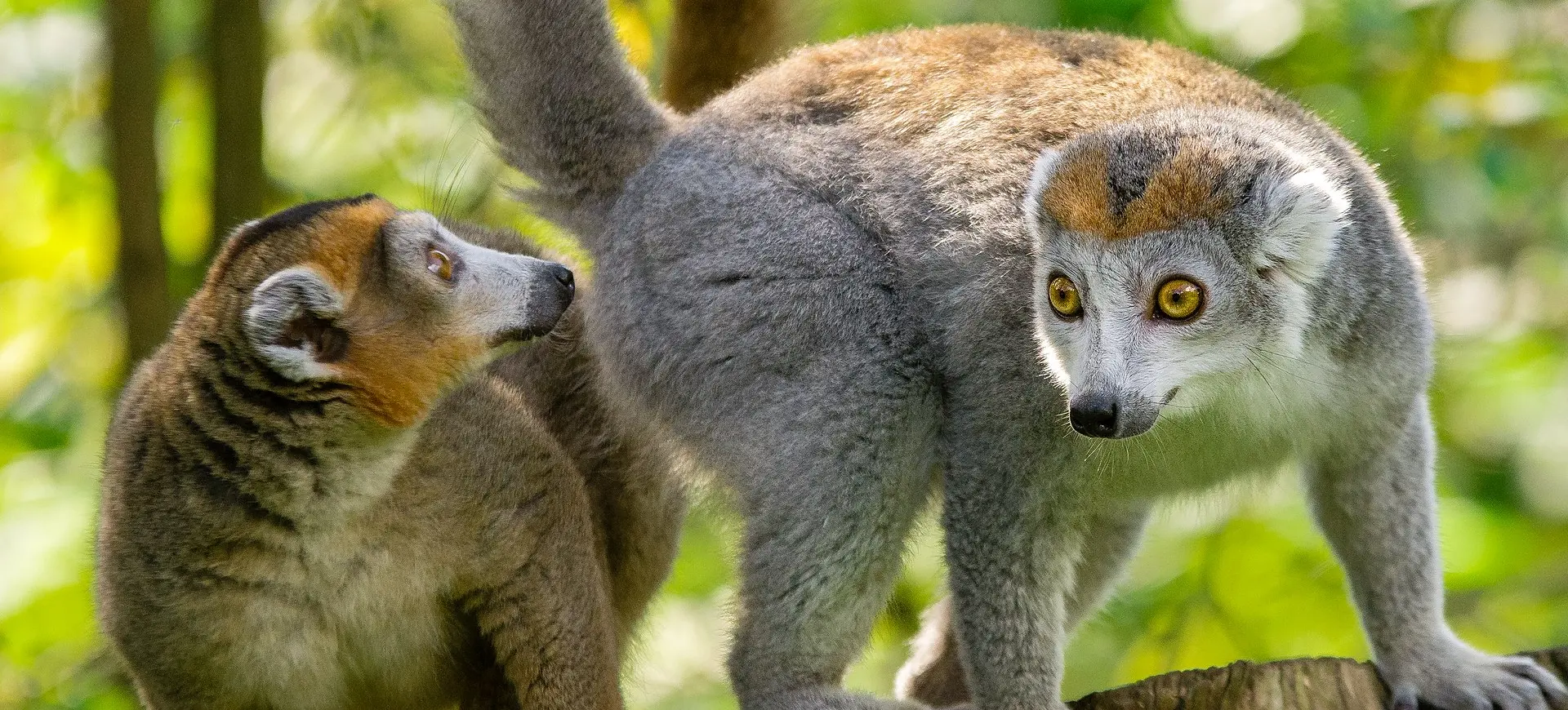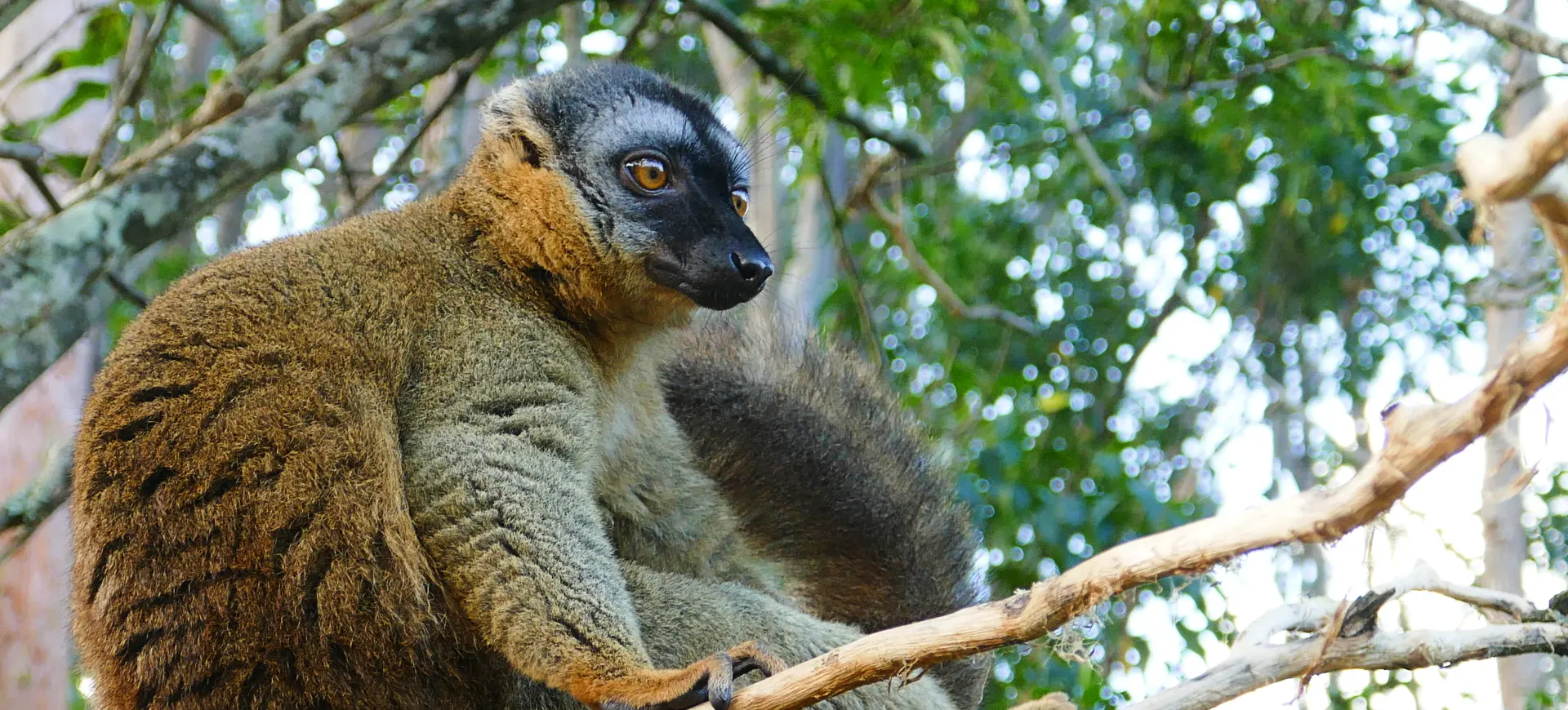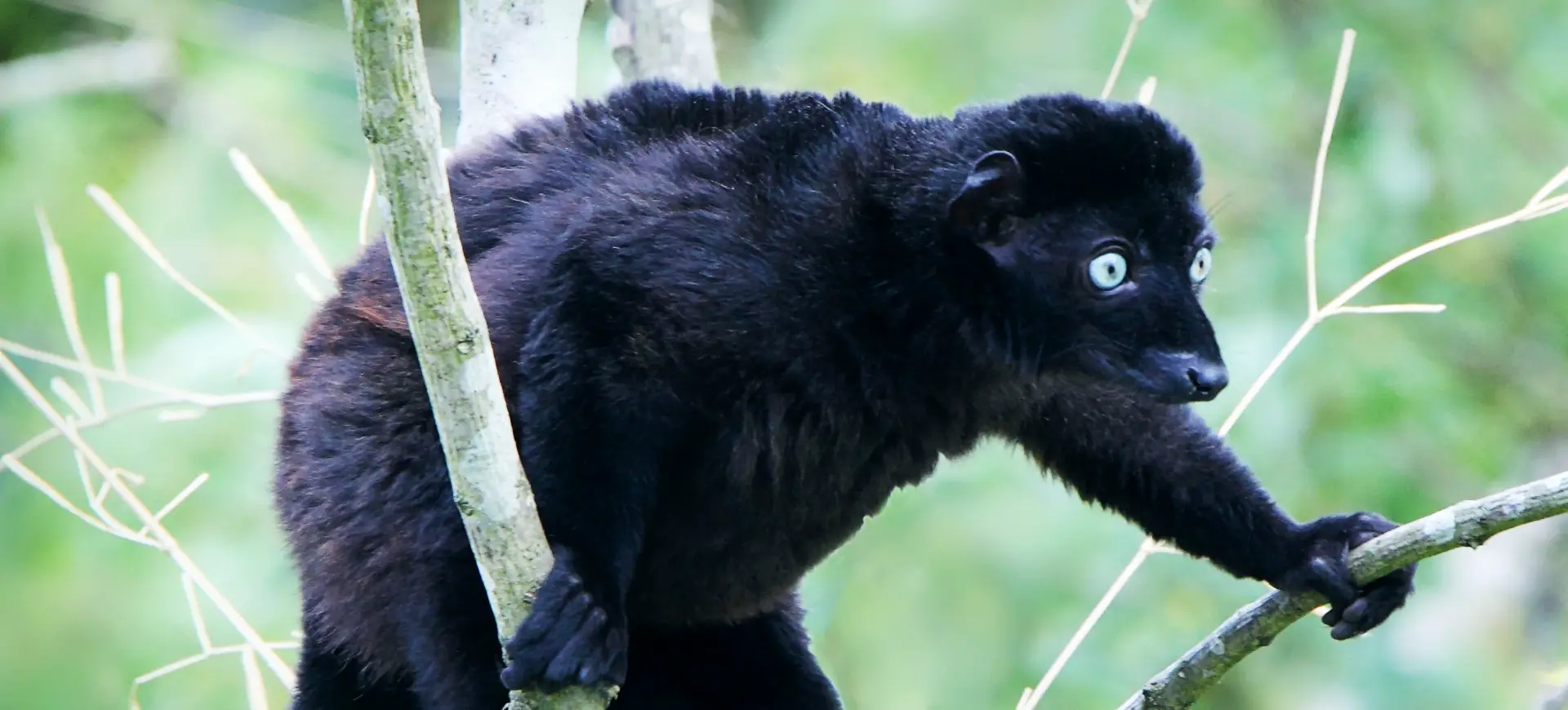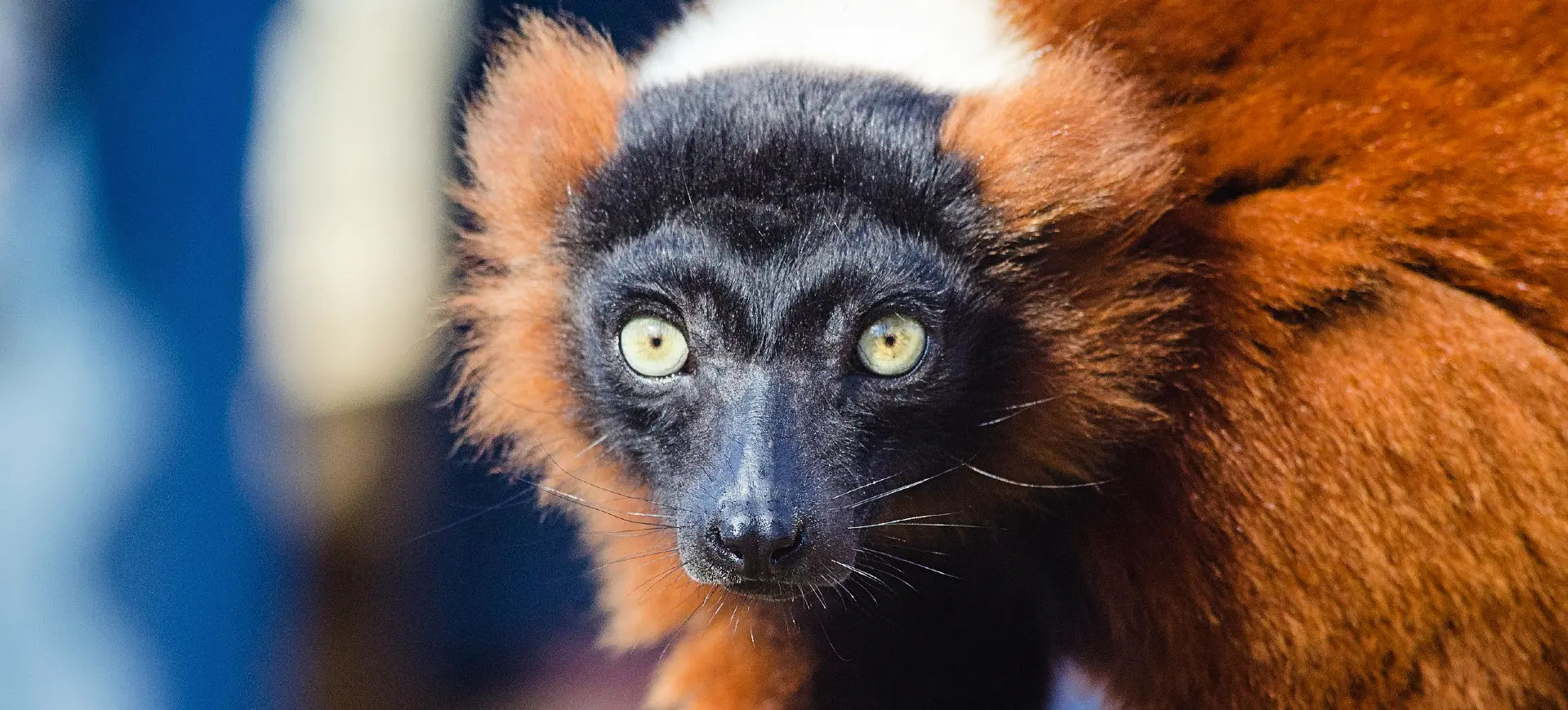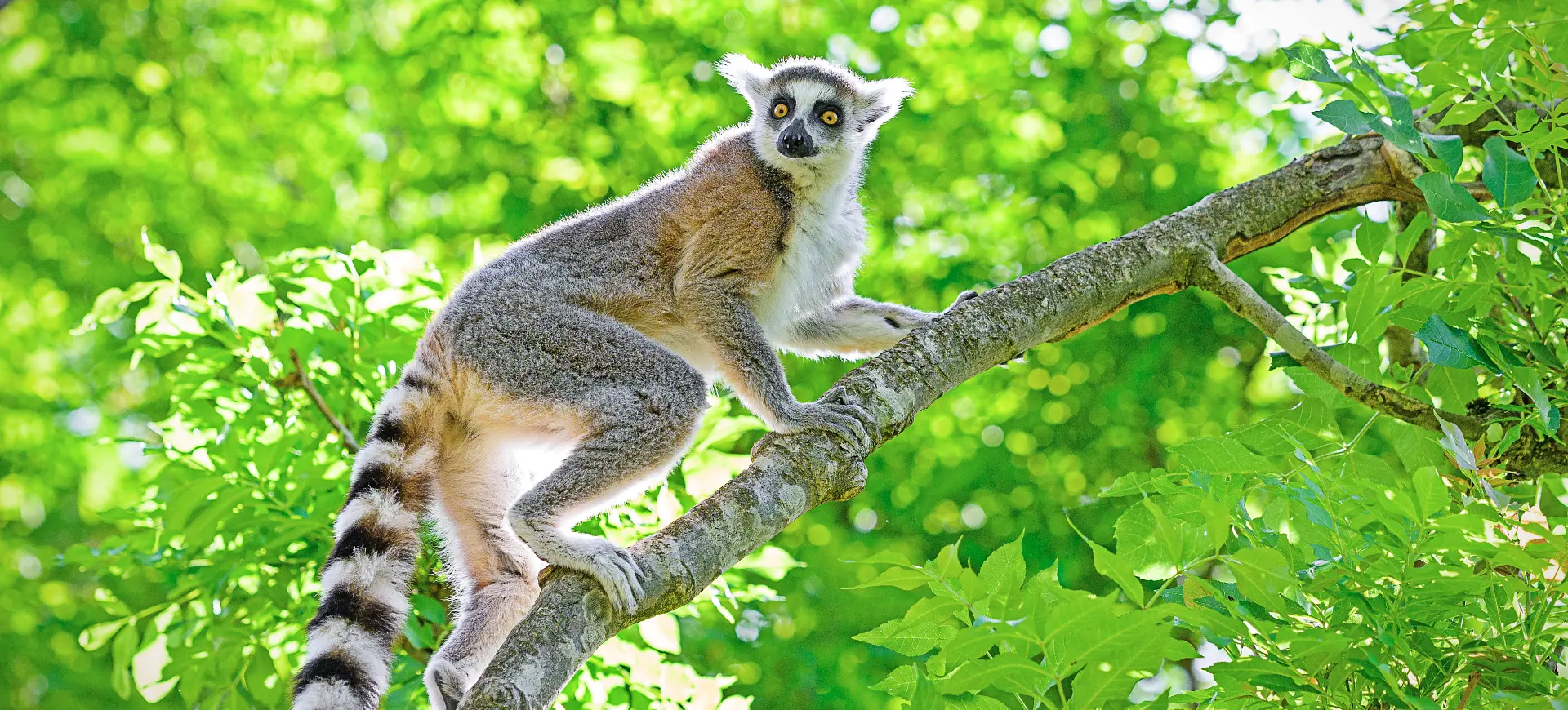Overview
The Black-and-White Ruffed Lemur is a striking and critically endangered primate species native to the tropical rainforests of Madagascar. Known for its black and white patterned fur and a distinctive ruff of long hair around its neck, it is one of the largest living species of lemur. These arboreal primates are highly vocal and social, often using loud calls to communicate with members of their group and warn others of potential threats. As a frugivorous species, they play a critical ecological role as seed dispersers, helping maintain the biodiversity of their rainforest habitats.
This species exhibits a unique reproductive strategy, with females giving birth to large litters and constructing nests for their young, a rare trait among primates. Black-and-white ruffed lemurs are diurnal and spend most of their time in the forest canopy, moving with agility using their strong limbs and long tails for balance. They live in small, flexible social groups with varying sizes depending on food availability and habitat conditions. Habitat destruction, hunting, and the illegal pet trade have severely impacted their populations, making them a conservation priority.
Historically found in the eastern rainforests of Madagascar, black-and-white ruffed lemurs now exist in fragmented populations restricted to protected areas and reserves. Conservation efforts, including habitat protection, reforestation, and captive breeding programs, aim to prevent extinction. Despite these efforts, their numbers continue to decline, highlighting the urgent need for more comprehensive strategies to safeguard their future. As charismatic and ecologically important primates, black-and-white ruffed lemurs symbolize the conservation challenges facing Madagascar’s unique wildlife.
Current distribution:
The Black-and-White Ruffed Lemur is found in a limited range in Madagascar's eastern rainforests. Due to ongoing deforestation for agriculture, logging, and mining, this distribution is increasingly fragmented. Protected areas, such as national parks and reserves, remain crucial sanctuaries for these lemurs, offering refuge from habitat loss and hunting pressures. Despite these protections, illegal activities within these areas continue to threaten their survival.
Conservation efforts are focused on expanding and connecting protected habitats to ensure genetic flow between isolated populations. Research and monitoring are ongoing to better understand their distribution and assess the effectiveness of conservation strategies. These initiatives are vital for preserving the Black-and-White Ruffed Lemur, aiming to secure a future for them in the wild amidst Madagascar's environmental challenges.
Physical Description:
Black-and-White ruffed Lemurs have a striking appearance, with thick, soft fur marked by a bold black-and-white pattern that varies among individuals and subspecies. Their heads, tails, and limbs are typically black, while their backs and flanks feature large white patches, and their necks are adorned with a fluffy white ruff. They have long tails, which can be as long as their bodies, aiding in balance and communication, especially during arboreal movement. Their large, expressive yellow eyes are framed by black facial fur, giving them excellent vision adapted for their diurnal lifestyle.
These lemurs have strong, muscular limbs adapted for leaping between tree branches in the rainforest canopy. Their hands and feet are equipped with grasping digits, including a grooming claw on the second toe, which they use for personal care and social grooming. Adults typically weigh between 6.6–10 lbs (3–4.5 kg) and measure about 20–24 inches (50–61 cm) in body length, with their tails adding 24–30 inches (61–76 cm). Males and females have similar physical appearances, making them difficult to distinguish visually.

Lifespan: Wild: ~15 Years || Captivity: ~25 Years

Weight: Male & Female: 20–24 in (50–61 cm)

Length: Male & Female: 44–54 in (112–137 cm) (including the tail)

Height: Male & Female: 20–24 in (50–61 cm)

Top Speed: 12 mph (19 km/h)
Characteristic:
Native Habitat:
Black-and-White Ruffed Lemurs are native to the eastern rainforests of Madagascar, an ecosystem characterized by high biodiversity and endemism. These forests provide a dense canopy and a varied understory, offering the lemurs an ideal habitat with ample food sources and nesting sites. The climate is humid and receives a high annual rainfall, supporting a diverse array of plant and animal life. The lemurs’ habitat is critical for survival, providing everything from food to protection from predators.
Their preference for primary rainforest makes them vulnerable to deforestation and habitat degradation, which are ongoing threats in Madagascar. The species relies on large, contiguous forest areas to maintain viable populations, making habitat fragmentation a significant concern for their conservation. Efforts to protect and restore these rainforest habitats are essential for the survival of Black-and-White Ruffed Lemurs, highlighting the importance of protected areas and sustainable land management practices.
Climate Zones:
Biomes:
WWF Biomes:
Biogeographical Realms:
Continents:
Countries:
Diet:
Diet & Feeding Habits:
Black-and-White Ruffed Lemurs are predominantly frugivorous, with fruit making up most of their diet, supplemented by leaves, nectar, and occasional invertebrates. This diet makes them crucial for their ecosystem as effective seed dispersers, aiding in the regeneration of their forest habitat. They have a particular preference for large and difficult fruits for other animals to process, using their strong jaws and specialized dentition to access the pulp and seeds. During periods of fruit scarcity, they may consume more leaves and nectar, showing adaptability in their feeding habits.
Their foraging behavior is highly social and can involve complex communication between group members to locate and share food sources. Black-and-White Ruffed Lemurs have been observed participating in communal feeding, where individuals gather in large numbers around abundant food sources. This facilitates feeding efficiency and reinforces social bonds within the group. Conservationists note the importance of preserving fruit-bearing trees in their habitat to support the lemurs’ dietary needs and ecological role.
Mating Behavior:
Mating Description:
Black-and-White Ruffed Lemurs have a unique reproductive strategy among primates. Females often give birth to multiple offspring after a gestation period of approximately 102 days. Mating typically occurs during the rainy season when food is abundant, ensuring the availability of resources for the nursing females. The species is known for constructing nests for their young, a behavior that protects the altricial infants during their first weeks of life. Males may assist in rearing the young, although maternal care is predominant.
The social dynamics of mating can be complex, with both males and females displaying selectivity in partner choice. This selectivity plays a role in maintaining genetic diversity within the population. Various factors, including habitat quality and group composition, influence breeding success in the wild. Conservation programs in captivity have contributed valuable insights into their reproductive biology, aiding in managing wild populations. These efforts highlight the importance of understanding and supporting natural behaviors to ensure the conservation of this species.
Reproduction Season:
Birth Type:
Pregnancy Duration:
Female Name:
Male Name:
Baby Name:
Social Structure Description:
The social structure of Black-and-White Ruffed Lemurs is characterized by flexible group dynamics, with both male and female members participating in group activities. Groups typically consist of 2 to 16 individuals, including adults of both sexes and their offspring. These lemurs exhibit various social behaviors, including grooming, play, communal nesting, strengthening social bonds, and facilitating group cohesion. Their vocal communication is essential to their social interactions, maintaining group cohesion and territory.
While they can be territorial, particularly during the breeding season, Black-and-White Ruffed Lemurs are also known for their ability to form temporary associations with other groups, especially in areas with abundant food resources. This flexibility in social organization allows them to adapt to their environment’s varying resource availability. Understanding these social dynamics is crucial for conservation efforts, particularly in designing protected areas and reintroduction programs that support their natural behaviors and social structures.
Groups:
Conservation Status:
Population Trend:
The Black-and-White Ruffed Lemur faces a critical conservation status, with wild populations declining due to habitat loss, hunting, and the illegal pet trade. These pressures have led to fragmented populations that are increasingly isolated from one another, complicating efforts for genetic diversity and species resilience. Conservationists are closely monitoring these populations, employing strategies such as habitat restoration and creating ecological corridors to facilitate movement between groups.
In captivity, these lemurs have been part of successful breeding programs, which not only help to ensure the species’ survival but also provide valuable information on their behavior, diet, and reproductive needs. These programs are essential for educating the public about lemurs and their plight, raising awareness, and supporting conservation efforts. The goal is to use knowledge gained from captive populations to inform and improve conservation strategies in the wild.
Population Threats:
The primary threats to the Black-and-White Ruffed Lemur include deforestation for slash-and-burn agriculture, logging, and mining, leading to significant habitat loss and fragmentation. Hunting for bushmeat and capture for the illegal pet trade also pose serious risks to their survival. These activities reduce the available habitat and directly decrease population numbers. Climate change exacerbates these threats, potentially altering habitat conditions and affecting the availability of food sources.
Efforts to combat these threats include strict enforcement of wildlife protection laws, habitat restoration, and community-based conservation programs. These initiatives aim to address the root causes of habitat destruction and illegal hunting, promoting sustainable practices that benefit local communities and wildlife. Conservationists emphasize the importance of integrated conservation strategies that include both protection of natural habitats and engagement with local communities.
Conservation Efforts:
Conservation efforts for the Black-and-White Ruffed Lemur are multifaceted, involving habitat protection, reforestation, and community engagement initiatives. Protected areas, such as national parks and reserves, are critical for providing safe habitats for these lemurs. Reforestation projects aim to restore degraded areas and connect fragmented habitats, facilitating gene flow and population recovery. Community-based conservation programs seek to involve local communities in conservation efforts, promoting sustainable livelihoods that reduce reliance on forest resources.
Education and awareness campaigns are vital for increasing local and global support for conservation efforts. Captive breeding programs contribute to the species’ genetic diversity and serve as an educational tool to highlight the importance of lemur conservation. International collaboration between governments, NGOs, and research institutions is essential for coordinating efforts and sharing best practices. These comprehensive conservation strategies are crucial for reversing the decline of the Black-and-White Ruffed Lemur and ensuring its survival for future generations.
Additional Resources:
Fun Facts
- Black-and-white ruffed Leurs are among the largest lemur species, and their striking fur pattern makes them one of the most recognizable.
- They can make leaps over 25 feet (7.6 meters) between trees, showcasing their incredible agility in the forest canopy.
- This species is one of the few primates that build nests for their young using branches and leaves.
- Their loud calls can serve as morning “wake-up calls” in the forest, echoing through the trees at dawn.
- Black-and-White Ruffed Lemurs have a highly developed sense of smell, which they use for communication and locating food.
- They play a crucial role in their ecosystem as seed dispersers, aiding in the regeneration of their rainforest habitat.
- Infants are born extremely altricially and rely heavily on maternal care for the first few weeks of life.
- This species exhibits high sociality, with complex group dynamics and communication systems.
- Conservation efforts for the Black-and-White Ruffed Lemur are vital for the overall biodiversity of Madagascar’s rainforests.
- They have a diverse diet but prefer fruit, making them important for pollinating and seed dispersing many tree species.


